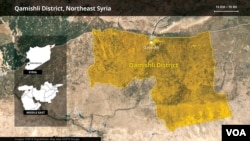A weakened and wary Islamic State terror group suffered a new round of setbacks when U.S. forces targeted three key leaders in two operations across northern Syria in a single day.
The U.S. confirmed the first operation, announcing that U.S. special forces had conducted a helicopter raid early Thursday near the northeastern village of Qamishli, in an area controlled by forces loyal to Syrian President Bashar al-Assad.
U.S. Central Command (CENTCOM), which oversees American forces in Syria and much of the Middle East, said the target of the operation, Rakkan Wahid al-Shammri, was killed and one of his associates was injured. Two other associates were captured.
U.S. military and intelligence officials described al-Shammri as a longtime IS operative who played a key role in smuggling weapons and fighters to support the terror group’s operations.
Activists with the London-based Syrian Observatory for Human Rights said that the early morning U.S. raid took place in the village of Moluk Saray, about 17 kilometers south of Qamishli, and that the target was killed after refusing to surrender.
The activists further identified the two men taken into custody as an Iraqi national and a commander of a "military security faction."
VOA could not independently confirm the activists' claims.
Later Thursday, the U.S. military delivered what may have been an even bigger blow, launching a precision airstrike just after 6 p.m. local time in northern Syria, killing two more high-ranking IS officials.
In a statement shared with VOA, CENTCOM said the strike killed Abu 'Ala, described as one of the terror group's "top five," who served as the deputy leader of ISIS in Syria.
A second IS official, Abu Mu'Ad al-Qahtani, said to be responsible for prisoner affairs, was also killed.
The airstrike was first reported by Fox News.
CENTCOM officials said that the airstrike was the result of "more than 1,000 hours of intelligence collection to each of the two targets" and that initial assessments showed no civilian casualties from the strike.
The U.S. strikes against IS came weeks after one of the top U.S. counterterrorism officials said IS has been stuck in "survival mode," unable, for now, to overcome unrelenting counterterrorism pressure from the United States.
The terror group is "no longer trying to attack the United States,” National Counterterrorism Center Director Christine Abizaid said last month, pointing to a series of decapitation strikes and arrests, starting with the February raid that led to the death of former IS emir Abu Ibrahim al-Hashimi al-Qurashi, also known as Hajji Abdallah.
In July, the U.S. said a drone strike in northwestern Syria had killed another "top five" IS leader, Maher al-Agal, described as the terror group's top Syrian official.
In June, U.S. special forces captured Hani Ahmed al-Kurdi, described as one of IS's more senior leaders, during a helicopter raid in Jarablus, in northwestern Syria.
U.S. allies and partners have also claimed significant victories against IS core leadership. Turkey confirmed last month the capture in May of Bashar Hattab Ghazal Al Sumaidai, a senior IS figure thought to have been one of a handful of officials in line to become the new emir.
Analysts who study IS, also known as ISIS, say the apparent success of the U.S. operations Thursday should not be minimized.
"To have killed ISIS's deputy emir for Syria is a significant achievement, given that Syria is clearly where ISIS is investing its resources most these days," said Charles Lister, director of the Washington-based Middle East Institute's Syria and Counterterrorism programs.
But while he noted the U.S. and its allies have "successfully eaten into the [IS] top ranks," Lister warned it would be a mistake for the West to let up now.
"Syria has long been the group's strategic depth, but today, it offers its greatest potential to fuel a future resurgence," he told VOA via text. "ISIS's attack tempo in northeastern Syria has markedly increased for several months. That makes these U.S. operations all the more important."
The United States has about 900 troops in Syria. But whether there is a need to boost that presence remains a question.
The U.S.-backed Syrian Democratic Forces announced last month another 105 IS-related arrests at the al-Hol displaced-persons camp, part of a counterterrorism operation that netted 121 arrests in August.
The SDF operation also recovered weapons caches and took down tents being used by IS followers to torture other camp residents.
The operation, supported by the U.S.-led coalition, also helped dismantle what coalition officials described as "a major ISIS facilitation network both within the camp and throughout Syria."
Thursday's strikes against IS, according to some experts, appear to be building successfully on those efforts by exploiting critical intelligence.
"Certainly, the two operations show continued U.S. pressure against ISIS elements in Syria. But more importantly, they show what effects the U.S. can generate with a light footprint," Katherine Zimmerman, a fellow at the American Enterprise Institute, told VOA via text.









